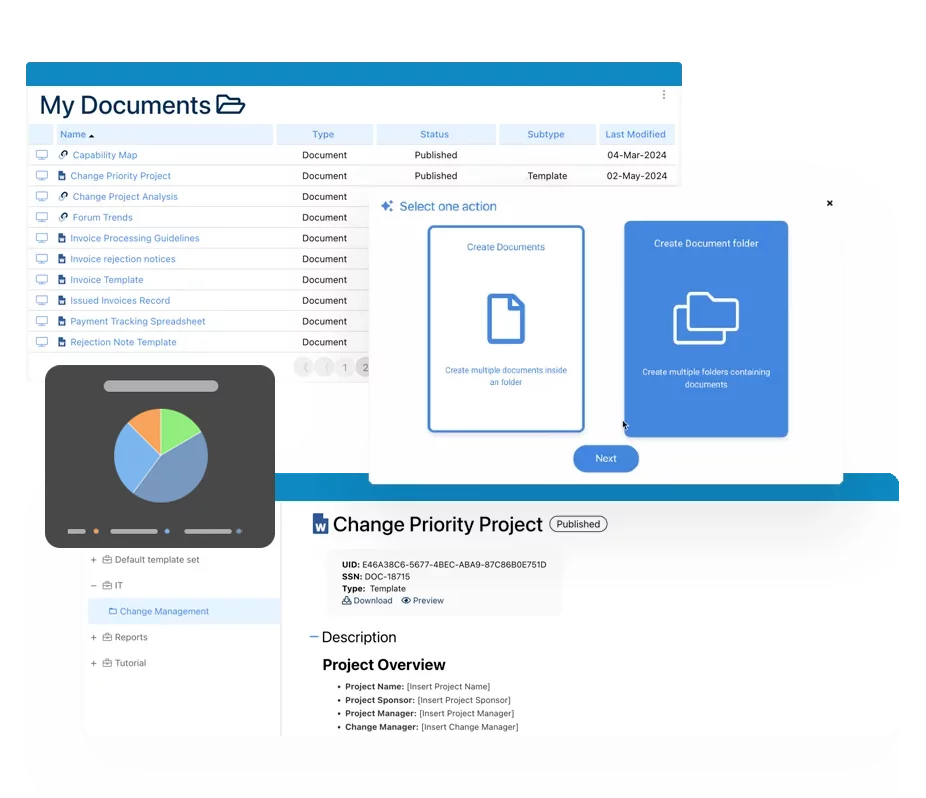- Business Process Management (BPM)Document Management System (DMS)Electronic Quality Management System (QMS)Risk, Governance & Compliance (GRC)Low Code Rapid Application Development (LC)Business Continuity Management (BCM)Enterprise Architecture (EA)Business Process Management (BPM)Document Management System (DMS)
- Document Control Overview
- AI Content Creation & Improvement
- Policy & Procedure Management (SOP)
- AI Content Mining Parser
- Collaboration & Governance
- Data Migration & Integration
- Interfacing Offline App
 Electronic Quality Management System (QMS)
Electronic Quality Management System (QMS)- Quality Management System Overview
- Document Control & Records Management
- Audit & Accreditation Management
- Corrective & Preventative Action
- Quality Event (Non-conformity / Complaint/ Compliance)
- Risk Management
- Incident Management
- Environmental Health & Safety
- Product & Supplier Management (SCAR)
- Training Management
- Control Management
- Action Items Management
- Management Review
- FMEA
- Pharmacovigilance
- Data Migration & Integration
 Risk, Governance & Compliance (GRC)
Risk, Governance & Compliance (GRC)- Risk, Governance & Compliance Overview
- Risk & Control Management
- Regulatory Compliance
- Collaboration & Governance
- Data Migration & Integration
- Interfacing Offline App
 Low Code Rapid Application Development (LC)
Low Code Rapid Application Development (LC)- Low Code Automation Platform Overview
- Electronic Web Form Design (eFORMS)
- Database Table Entity Designer
- System Integration Designer
- Design & Manage Tasks
- Design & Manage BPMS Apps
- Custom Rules/Guards/Actions
- Electronic Services
- User Homepage
- BAM (Business Activity Monitoring)
- Custom Dashboard Design
- Data Migration & Integration
 Business Continuity Management (BCM)
Business Continuity Management (BCM)- Business Continuity Management Overview
- Business Impact Analysis
- Disaster Recovery Simulation
- Action Item Management
- Mass Notification Management
- Asset Management
- Interfacing Offline App
 Enterprise Architecture (EA)
Enterprise Architecture (EA) - IndustriesRegulatory ComplianceUse CasesLearning CenterFramework & PracticesIndustries
- Healthcare
- Medical Device Technology
- Life Science, Pharmaceutical
- Aerospace & Defense
- Airlines and Aviation
- Media & Telecommunications
- Government and Military
- Technology
- Energy
- Logistics & Port Operations
- Banking & Capital Markets
- Retail & Consumer
- Consulting
- Education
- Engineering & Construction
- Manufacturing
- Financial Services
- Insurance
- Chemicals
Regulatory Compliance- Regulatory Compliance
- ISO
- ISO 9001 (guide)
- ISO 9001:2026 (preparation)
- ISO 17025
- ISO 27000
- ISO 27001
- ISO27002
- ISO 42001
- EU AI Act
- SOC 2 Type 1 & 2
- Sarbanes Oxley
- GxP
- GRC
- Basel
- Digital Signature
- GDPR
- IFRS
- NIST SP 800-53
 Use Cases
Use Cases- Quality Management System (QMS)
- Digital Transformation
- Continuous Improvement
- Governance, Risk & Compliance
- Knowledge Management
- System Deployment (ERP, CRM…)
 Learning CenterFramework & Practices
Learning CenterFramework & Practices - AboutCustomer SuccessPartners



Business Process Management Services
Please Select contact form.
Implement BPM to actively manage your business processes with the help of Interfacing’s BPM Professionals.

What is Business Process Management?
There are many different definitions and interpretations of Business Process Management (BPM). Unfortunately, many of these interpretations are using the term BPM as synonymous with:
- Process Automation or
- Process Improvement
While BPM includes these capabilities, it is not restricted to solely either or both of them. Rather, BPM should be seen as a management discipline to assist organizations to better understand and control their business processes. BPM aims to improve a business process from end to end by analyzing it, modelling how it works in different scenarios, executing improvements, monitoring the improved process and continually optimizing it.
In their book Fundamentals to Business Process Management, Marlon Dumas, Marcello La Rosa, Jan Mendling, Hajo A. Reijers define BPM as:

"…the art and science of overseeing how work is performed in an organization to ensure consistent outcomes and to take advantage of improvement opportunities. In this context, the term “improvement” may take different meanings depending on the objectives of the organization."
Gartner defined Business Process Management as:

"a discipline that uses various methods to discover, model, analyze, measure, improve and optimize business processes. A business process coordinates the behavior of people, systems, information and things to produce business outcomes in support of a business strategy."
While BPM’s overriding objective is to improve the efficiency and effectiveness of an organization’s business processes, it is not just about applying one method and approach over another. Instead, BPM is an organization’s journey to:
Not surprisingly, it is possible to undertake a BPM program without the use of any technology, but that is neither the most effective or best way to do so. Interfacing’s Enterprise Process Center has been designed from the ground up, to facilitate and deliver on all the objectives of BPM programs.
The answer to this question is very simple, anywhere. You do not and probably should not do the whole organization at the one time. Choose a small area in which to undertake a proof of concept as the starting point and allow the organization to build confidence in how BPM helps improve your organization.
A properly designed BPM program should only cause minimal impact, if any, on the organization. The program should be cognizant of the business process lifecycles and the nature of any seasonality that impacts the organization. Plus, you should break-down the program in to bite sized chunks. For example, retailers would not launch a new IT system or organizational change during the holiday season, so why would you launch a BPM program at this time.
Calculating the return on investment can seem to be difficult, because there will be savings that are directly related to the processes be managed and improved, but there will also be indirect savings as well as qualitative benefits delivered. Organizations will benefit from just defining and documenting their processes even before they begin measuring process performance and then improving them. A recent Gartner BPM study found organizations adopting BPM are much more likely to achieve their desired business outcomes and 80% of organizations conducting BPM programs achieve an internal rate of return better than 15%.
This may well be true, but does your organization have all your processes: Documented? Conformance to the Processes measured and reported? Performance measured and reported, including process efficiency and effectiveness? Prioritized for potential improvement or automation? If the answer to any or all these questions is no, then you cannot know how well your processes are performing, whether they need to improved or automated.
Benefits

Simplified
Operations
Conducting a BPM Program will lead to end to end business processes that have been documented, analyzed, executed, measured, simplified, improved, optimised and potentially automated. All the details of how to perform the process should be at the finger-tips of employees and contractors.
Reduced
Risks
Whether you operate in a highly regulated industry or not, it is important while performing a business process that all risks likely to arise are identified and mitigated. Once identified, appropriate controls are designed to mitigate the risks. Process documentation should highlight steps where controls are implemented within the process. Reporting is also beneficial to ensure process controls are being performed correctly.
Improved
Predictability
Ensuring business processes are as effective and efficient as possible means that unexpected errors should be eliminated or at worst significantly reduced. The means performing these business process should result in improved consistency and predictability.
Enhanced
Process Consistency
In addition to improved predictability, business processes will be performed with a reduction in errors occurring during the execution of each process. This will drive enhanced consistency across not only the individual processes but also the end to end processes.
Lower
Costs
An additional beneficial outcome from simplifying operations will be a lowering of process costs. This is achieved by removing waste and non-value adding activities within each process.
Superior Quality
and Brand Protection
Following on from the simplifying operations, improved predictability and enhanced consistency are more effective processes that consistency better outcomes. These better outcomes will lead to better quality outcomes for customers and partners. This will also lead to increased positive customer and partner perception of the organization’s brand.
Methodology
The most common approach to conducting a BPM program is based on 5 steps:

PLAN
The first step, Plan, in the BPM method is used to determine the scope of the planned BPM program to be undertaken. The scope can be performed multiple different ways as each organization will have their own specific context and circumstances. However, the two most common ways are to take a functional or team-based approach or an end to end process approach. While both have pros and cons, using an end to end process approach ensures you analyse and design a complete set of processes that deliver business outcomes. Using a functional or team-based approach runs the risk of missing something that occurs when processes are handed off between functions.
DESIGN
This step, Design, covers both identifying and redesigning existing processes and the design of future processes. Design will address:
- Individual processes within the scope end to end processes to determine the right activities needed and the applications and information required to deliver the outcomes of expected of each process
- The overall flow within the end to end processes to reduce hand-offs between roles / teams and to eliminate or significantly reduce process failures
- Address the relevant competition, market, regulative and legislative business challenges that may arise during the execution of the process
- Appropriate alerts, escalations, notifications, service level agreements within individual processes or across the process within the end to end process.
MODEL
Model, takes the outputs of the Design step and uses this information to model various scenarios to identify how changes to inputs impact process. This may also involve undertake simulations of the process to understand the impact of changing constraints, such as on changes to its inputs or costs.
For example, modelling changes to process volumes or input materials costs, will assess how the process might operate under different situations. It also allows evaluation of changes to organization objectives, such as “What is the impact of an unexpected 50% drop in orders” or “What can I do to reduce the unit by 20%”.
EXECUTE
Execute, involves implementing and performing the processes designed in Step 2 using the knowledge gained from the modelling of processes and their constraints in Step 3. Processes can be executed manually or be automated.
MONITOR
Monitor, encompasses measuring and reporting of the performance KPI’s for both individual processes and end to end processes against their set performance targets. These KPI’s can cover different measures for process effectiveness, efficiency, service level and customer experience. For example, cycle time, error rate, resource effort,
The approach required to measuring performance KPI’s will largely depend on the type of KPI and the availability of information needed for measurement. It may be necessary to collect data needed to calculate the performance KPI. This data collection and calculation will depend on the context and circumstances of individual organisations. In some organisations, this may be a manual or partially manual process, but in most situations it will be automated.
The performance metrics can also be used to work with partners, suppliers and potentially customers to improve how they connect with the organisation, by using KPI’s to analyse how to best connect with their processes.
OPTIMIZE
Optimize, involves analysing the process performance to identify processes that are not meeting their performance targets or the organisation is looking to change. These changes can be driven by many different external and internal influences.
External influences can be due to changes in:
Internal influences can be due business stakeholders looking to:
Deliverables
PLAN
Typical deliverables from the Plan step are:
DESIGN
Typical deliverables from the Design step are:
Repository of documented Processes, which will include process maps, process definitions, performance metrics, roles and responsibilities, risks and controls.
MODEL
Typical deliverables from the Model step are:
EXECUTE
Typical deliverables from the Execute step are:
MONITOR
Typical deliverables from the Monitor step are:
OPTIMIZE
Typical deliverables from the Optimize step are:
Why Choose Interfacing?
With over two decades of AI, Quality, Process, and Compliance software expertise, Interfacing continues to be a leader in the industry. To-date, it has served over 500+ world-class enterprises and management consulting firms from all industries and sectors. We continue to provide digital, cloud & AI solutions that enable organizations to enhance, control and streamline their processes while easing the burden of regulatory compliance and quality management programs.
To explore further or discuss how Interfacing can assist your organization, please complete the form below.

Documentation: Driving Transformation, Governance and Control
• Gain real-time, comprehensive insights into your operations.
• Improve governance, efficiency, and compliance.
• Ensure seamless alignment with regulatory standards.

eQMS: Automating Quality & Compliance Workflows & Reporting
• Simplify quality management with automated workflows and monitoring.
• Streamline CAPA, supplier audits, training and related workflows.
• Turn documentation into actionable insights for Quality 4.0

Low-Code Rapid Application Development: Accelerating Digital Transformation
• Build custom, scalable applications swiftly
• Reducing development time and cost
• Adapt faster and stay agile in the face of
evolving customer and business needs.
AI to Transform your Business!
The AI-powered tools are designed to streamline operations, enhance compliance, and drive sustainable growth. Check out how AI can:
• Respond to employee inquiries
• Transform videos into processes
• Assess regulatory impact & process improvements
• Generate forms, processes, risks, regulations, KPIs & more
• Parse regulatory standards into requirements

Request Free Demo
Document, analyze, improve, digitize and monitor your business processes, risks, regulatory requirements and performance indicators within Interfacing’s Digital Twin integrated management system the Enterprise Process Center®!
Integration
Discover how we helped other Companies succeed






























